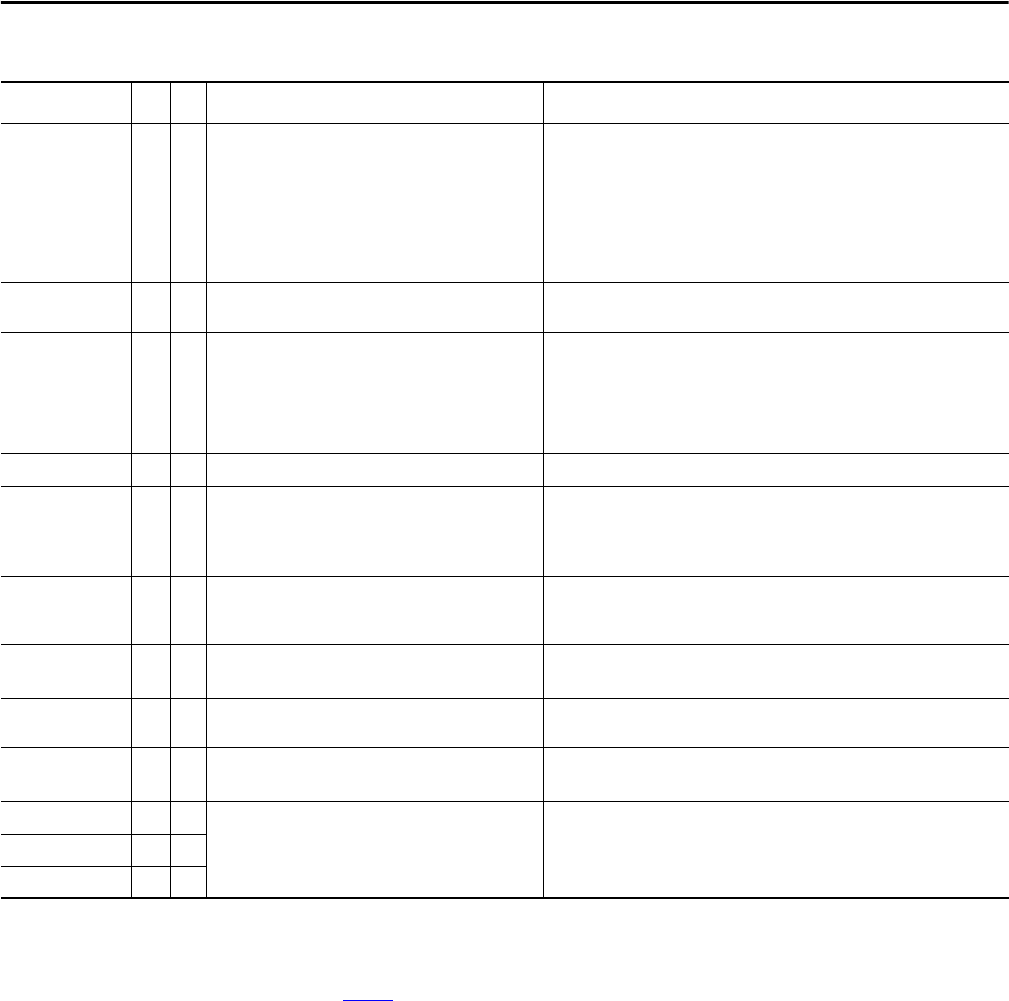Owner's manual
Table Of Contents
- Front Cover
- Important User Information
- Summary of Changes
- Table of Contents
- Introduction
- About the Drive
- Identifying the Drive by Cabinet Assembly ID Number
- LiquiFlo 2.0 Drive Component Locations
- Identifying the Power Module by Model Number
- AC Line I/O Board Description (Frame 3 Only)
- Standard I/O Board Description (Frame 3 Only)
- Combined I/O Board Description (Frame 4 Only)
- DPI Communication Ports
- Optional Equipment
- Planning the Installation
- Mounting The Power Module and Grounding the Drive
- Installing Input and Output Power Wiring
- Completing the Installation
- Using the Start-up Routines
- Programming Basics
- Parameter Descriptions
- Troubleshooting the Drive
- Verify that the DC Bus Capacitors are Discharged Before Servicing the Drive
- Determining Drive Status Using the Status LEDs
- About Alarms
- About Faults
- Diagnostic Parameters
- Common Symptoms and Corrective Actions
- Replacement Parts
- Board Replacement, Firmware Setup Procedures
- Troubleshooting the Drive Using the OIM
- Checking the Power Modules with Input Power Off
- Technical Specifications
- Using the OIM
- Installing and Removing the OIM
- Display Description
- OIM Menu Structure
- Powering Up and Adjusting the OIM
- Selecting a Device in the System
- Using the OIM to Program the Drive
- Monitoring the Drive Using the Process Display Screen on the OIM
- Displaying and Changing the OIM Reference
- Customizing the Process Display Screen
- Customizing the Function Keys
- Controlling the Drive From the OIM
- LiquiFlo 2.0 Drive Frame 3 Wiring Diagrams
- LiquiFlo 2.0 Drive Frame 4 Wiring Diagrams
- Index
- Back Cover

208 Rockwell Automation Publication D2-3518-3 - May 2013
Chapter 10
Frame 4 Fault Descriptions and Corrective Actions
Tab le describes drive faults and corrective actions for Frame 4 (firmware version
2.x only). It also indicates if the fault is:
1 Auto-resettable, and can also be reset using normal fault clearing mechanisms.
2 Non-resettable
3 User-configurable, and can be reset using normal fault clearing mechanisms.
4 Normal fault*
*The fault is resettable using normal fault clearing mechanisms on the drive
(Stop/Reset button, powercycling, etc.) or through VS Utilities.
Rctfr Over Cur R,S,T 211
212
213
4 Rectifier overcurrent.
See description of rectifier IOC Redir Time (300) and IOC
Redir Max (301) for discussion of alternative reporting of
rectifier instantaneous overcurrent (IOC) faults.
1. High line current can be caused by high load current. Verify that rectifier
overcurrent was not caused by sudden increase in motor (inverter) current.
2. Low input voltage can result in increased current load. Provide proper input
voltage to the drive.
3. AC line events such as short duration shorts in the nearby grid can cause
sudden line current increases. Verify that such events have not occurred.
4. Verify proper motor data is entered on inverter.
5. Reduce rectifier current limit using rectifier Current Limit parameter (105).
Rctfr Over Volt 224 4 The DC bus voltage is too high. Monitor the AC line for high line voltage or transient conditions. Bus overvoltage
can also be caused by motor regeneration. Extend the decel time.
Rctfr Pwr Board 235 2 Drive rating information stored on the rectifier power
board is incompatible with rectifier application firmware,
or drive rating information stored on the rectifier power
board was corrupted or could not be read from rectifier
power board by rectifier firmware.
1. Check connections between rectifier control board and rectifier power interface
board. If this fixes the issue, then use rectifier Reset To Defaults (rectifier 197)
to reset the rectifier to its defaults, then reconfigure the drive as needed.
2. Load updated drive rating information onto rectifier.
3. Load updated rectifier application firmware.
4. Replace rectifier power board.
Reactor Temp 214 4 Temperature switch in reactor opened. Check for proper temperature and fan operation.
Replaced MCB-PB 107 2 Inverter control board or inverter power board was
replaced.
This fault can be cleared by writing a nonzero value to
inverter Reset To Defaults parameter (197).
1. Restore inverter defaults (inverter parameter 197).
2. Reprogram parameters.
Ride Thru Abort 221 4 Input power loss timed out, rectifier Ride Through Ena
(rectifier 64) is set to Enabled.
1. Verify input power and connections.
2. Check Line Sync board.
3. Check AC Line I/O board.
Shear Pin 63 1
3
Programmed Current Lmt Val (148) has been exceeded.
Enabled/disable with inverter Fault Config 1 (238).
Check load requirements and Current Lmt Val (148) setting.
SW OverCurrent 36 1 The drive output current has exceeded the software
current limit.
Check for excess load, improper DC boost setting. DC brake volts set too high.
UnderVoltage 4 1
3
DC bus voltage fell below the minimum value of 305V DC.
Enable/disable with inverter Fault Config 1 (238).
Monitor the incoming AC line for low voltage or power interruption.
UserSet1 Chksum 101 2 The checksum read from the user set does not match the
checksum calculated.
These faults can be cleared by writing a nonzero value to
inverter Save To User Set (199).
Re-save user set using inverter Save To User Set (199).
UserSet2 Chksum 102 2
UserSet3 Chksum 103 2
Table 21 - Fault Descriptions and Corrective Actions (Frame 3) (Continued)
Fault
No.
Type
Description Action










